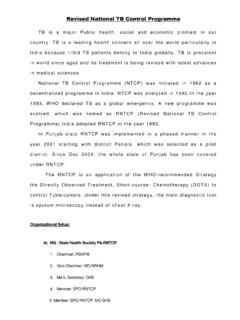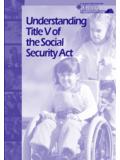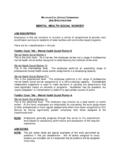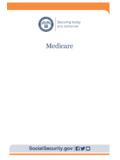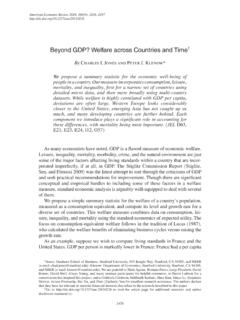Transcription of Introduction of Family Welfare Programme
1 NATIONAL Family Welfare Programme Introduction India launched the National Family Welfare Programme in 1951 with the objective of "reducing the birth rate to the extent necessary to stabilize the population at a level consistent with the requirement of the National economy. The Family Welfare Programme in India is recognized as a priority area, and is being implemented as a 100% Centrally sponsored Programme . EVOLUTION OF FW PROGRAM The approach under the Programme during the First and Second Five Year Plans was mainly "Clinical" under which facilities for provision of services were created.
2 However, on the basis of data brought out by the 1961 census, clinical approach adopted in the first two plans was replaced by "Extension and Education Approach" which envisaged expansion of services facilities along with spread of message of small Family norm. In the IV Plan (1969-74), high priority was accorded to the Programme and it was proposed to reduce birth rate from 35 per thousand to 32 per thousand by the end of plan. million couples, constituting about of the couples in the reproductive age group, were protected against conception by the end of IVth Plan.
3 The objective of the V plan (1974-79) was to bring down the birth rate to 30 per thousand by the end of 1978-79 by increasing integration of Family planning services with those of Health, Maternal and Child Health (MCH) and Nutrition, so that the Programme became more readily acceptable. The years 1975-76 and 1976-77 recorded a phenomenal increase in performance of sterilisation. However, in view of rigidity in enforcement of targets by field functionaries and an element of coercion in the implementation of the Programme in 1976-77 in some areas, the Programme received a set-back during 1977-78.
4 As a result, the Government made it clear that there was no place for force or coercion or compulsion or for pressure of any sort under the Programme and the Programme had to be implemented as an integral part of " Family Welfare " relying solely on mass education and motivation. The name of the Programme also was changed to Family Welfare from Family Planning. In the VI Plan (1980-85), certain long-term demographic goals of reaching net reproduction rate of unity were envisaged. The Family Welfare Programme during VII five year plan (1985-90) was continued on a purely voluntary basis with emphasis on promoting spacing methods, securing maximum community participation and promoting maternal and child health care.
5 The Universal Immunization Programme (UIP) was launched in 1985 to provide universal coverage of infants and pregnant women with immunization against identified vaccine preventable diseases and extended to all the districts in the country The approach adopted during the Seventh Five Year Plan was continued during 1990-92. For effective community participation, Mahila Swasthya Sanghs(MSS) at village level was constituted in 1990-91. MSS consists of 15 persons, 10 representing the varied social segments in the community and five functionaries involved in women's Welfare activities at village level such as the Adult Education Instructor, Anganwari Worker, Primary School Teacher, Mahila Mukhya Sevika and the Dai.
6 Auxiliary Nurse Midwife(ANM) is the Member-Convenor. From the year 1992-93, the UIP has been strengthened and expanded into the Child Survival and Safe Motherhood (CSSM) Project. It involves sustaining the high immunization coverage level under UIP, and augmenting activities under Oral Rehydration Therapy, prophylaxis for control of blindness in children and control of acute respiratory infections. Under the Safe Motherhood component, training of traditional birth attendants, provision of aseptic delivery kits and strengthening of first referral units to deal with high risk and obstetric emergencies were being taken up.
7 To impart new dynamism to the Family Welfare Programme , several new initiatives were introduced and ongoing schemes were revamped in the Eighth Plan (1992-97). Realizing that Government efforts alone in propagating and motivating the people for adaptation of small Family norm would not be sufficient, greater stress has been laid on the involvement of NGOs to supplement and complement the Government efforts. Reduction in the population growth rate has been recognized as one of the priority objectives during the Ninth & Tenth Plan period.
8 The strategies are: i) To assess the needs for reproductive and child health at PHC level and undertake area-specific micro planning. ii) To provide need-based, demand-driven, high quality, integrated reproductive and child health care reducing the infant and maternal morbidity and mortality resulting in a reduction in the desired level of fertility. CONTRACEPTIVES The National Family Welfare Programme provides the following contraceptive services for spacing births: a) Condoms b) Oral Contraceptive Pill c) Intra Uterine Devices (IUD) Whereas condoms and oral contraceptive pills are being provided through free distribution scheme and social marketing scheme, IUD is being provided only under free distribution scheme.
9 Under Social Marketing Programme , contraceptives, both condoms and oral pills are sold at subsidized rates. In addition, contraceptives are commercially sold by manufacturing companies under their brand names also. Govt. of India does not provide any subsidy for the commercial sale. COPPER-T Cu-T is one of the important spacing methods offered under the Family Welfare Programme . Cu-T is supplied free of cost to all the States/UTs by Govt. of India for insertion at the PHCs, Sub-centres and Hospitals by trained Medical Practitioners/trained Health Workers.
10 The earlier version of Cu-T 200 B (IUDs) has been replaced by Cu-T 380-A from 2002-03 onwards which provides protection for a longer period(about 10 years) as against Cu-T 200 B which provided protection for about 3 years only. EMERGENCY CONTRACEPTIVE PILL (ECP) was introduced under Family Welfare Programme during 2002-03. The emergency contraceptive is the method that can be used to prevent unwanted pregnancy after an unprotected act of sexual intercourse (including sexual assault, rape or sexual coercion) or in contraceptive failure.
